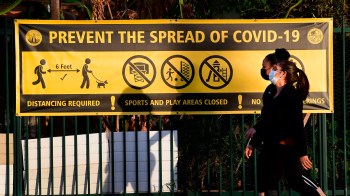L.A. Auto Show gets more compact
TEXT OF INTERVIEW
Kai Ryssdal: The Los Angeles Auto Show opened to the general public today. But as is the custom, the L.A. Convention Center has been open to members of the media since Wednesday. Reporters get two whole days to walk the floors and talk to auto executives.
Former General Motors CEO Fritz Henderson was a late scratch from the list of speakers Tuesday afternoon. The board at General Motors had other plans. Mr. Henderson lost his job right before things got started. And he was not, as it turns out, the only no-show.
Dan Neil covers the car industry for the Los Angeles Times. Dan, good to have you back.
Dan Neil: Nice to be here.
Ryssdal: Other than Fritz Henderson not showing up at the L.A. car show, it is also just a smaller affair this year. How come?
Neil: A lot of manufacturers have decided not to come to this show to save money or to not appear they’re spending a lot of money. Nissan, for example, which is a giant manufacturer, skipped the show altogether. Plus, you have your luxury marks, like Ferrari, Lamborghini, Maserati, for their own reasons and for their own bottom lines, they decided to skip the show.
Ryssdal: So if you and I walked out of Figueroa Street, eight, 10 blocks, whatever it is, what are we going to see, what is going to jump out at us?
Neil: Well, you’ll still see a lot of really nice cars and you’ll also see kind of the changing of the guard. For example, Suzuki being very aggressive going after the mid-level luxury market. And you see Hyundai going after Lexus and Mercedes in a big way.
Ryssdal: Where does Detroit go from here? I mean, if car shows are getting smaller and foreign companies are getting increased market shares, what happens?
Neil: Well, Ford is doing very well. They’ve stabilized. They’ve got some very interesting product on the way. They’ve got the Ford Fiesta and, on the Mazda side of the Ford corporate, they’ve got the Mazda2. Both very charismatic, small cars on the same platform. General Motors has put so much of its authority and its image and its prestige and really, a fair amount of money, into the Chevy Volt.
Ryssdal: You drove it the other day. You liked it.
Neil: Yeah, yeah. It’s a nice car. It looks good and it drives pretty nicely. Now, it has 40 miles of all electric range. And in that electric range it feels like a very big, very sophisticated golf cart.
Ryssdal: Is it going to be big enough to make it work for them?
Neil: Well, you know, they’re going to build 10,000 of them in the first year. But the question is, will people buy them? There’s this push against General Motors, because they’re “Government Motors.” So a lot of people are holding off there. It’s also an untried technology. A lot of people are going to wait and see and a lot of people may not want to plug in or wire their house with a plug in. And it also appeals to a much more narrow demographic. You know, if you don’t have a garage and a place to plug this car in, it’s not the right car for you. So there are some hills to cross for this car, but still, if it works — and I’m not saying it will, I’m not saying it won’t — but if it works, it could be a huge car for General Motors.
Ryssdal: I’ve got to tell you, that sounds like a resounding “maybe.”
Neil: They could carve it in 10-foot letters. I mean, nobody knows. Also, Nissan is building an electric car, hundreds of thousands of electric cars in the next several years. We don’t know that there’s a market for them; they don’t know that there’s a market for them. What if gas goes to $2 a gallon? There won’t be a market for them. I mean, I hope so. I want to think that there will be, but I’ve gotta rein my optimism in with some sense of reality.
Ryssdal: And yet, these auto shows. We still have them and they’re still huge marketing expenses and all this stuff for these companies. They’re never going to go away.
Neil: It’s interesting. They started out as consumer shows, then they became sort of platforms for the manufacturers to show off their latest greatest technology. This show, the L.A. show, and other shows on the U.S. circuit, are sort of turning back the other way. Because it really is now more about the people who are coming through the door, not on press days, but on the regular days. People who want to kick the tires.
Ryssdal: And I will say, you and I went down, I guess, two years ago now. It’s a fun experience. They put on a really good show.
Neil: Oh yeah, it’s really nice and it’s a giant warehouse full of brand new cars. You know, there are some things that just can’t be beat.
Ryssdal: That’s true. Dan Neil writes on cars for the Los Angeles Times. Dan, thanks a lot.
Neil: Thanks Kai.
There’s a lot happening in the world. Through it all, Marketplace is here for you.
You rely on Marketplace to break down the world’s events and tell you how it affects you in a fact-based, approachable way. We rely on your financial support to keep making that possible.
Your donation today powers the independent journalism that you rely on. For just $5/month, you can help sustain Marketplace so we can keep reporting on the things that matter to you.


















